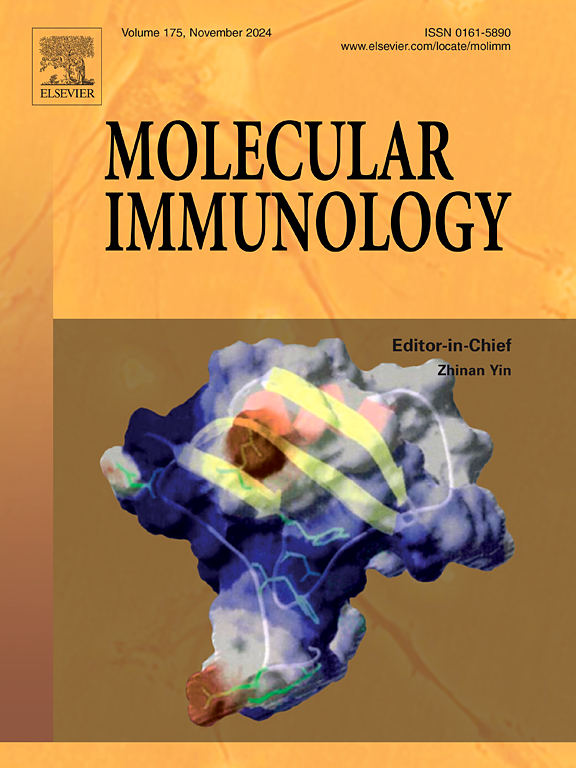IgA血管炎肾炎中Tph细胞扩增
IF 3.2
3区 医学
Q2 BIOCHEMISTRY & MOLECULAR BIOLOGY
引用次数: 0
摘要
异位淋巴样结构(ELSs)有助于维持IgA血管炎肾炎(IgAVN)的慢性炎症过程,并与更严重的疾病病程相关。PD-1hiCXCR5−CD4+ T外周辅助细胞(Tph)被认为是主要的CD4+ T细胞,在ELSs中参与B细胞免疫应答和抗体产生。然而,Tph细胞在IgAVN发病机制中的作用目前尚不清楚。在这里,我们发现IgAV患者的循环Tph (cTph)细胞频率高于健康对照组,肾炎患者的循环Tph (cTph)细胞频率高于无肾炎患者。此外,IgAVN患者cTph细胞频率与24小时尿蛋白和尿红细胞水平呈正相关。IgAVN患者的cTph细胞表达高水平的激活因子和B细胞辅助标志物,包括ICOS、Tigit、IL-21和CXCL13,并在IL-21存在下诱导记忆B细胞体外分化。综上所述,这些结果表明PD-1hiCXCR5−CD4+ cTph细胞通过IL-21诱导B细胞分化参与IgAVN的发病过程,是治疗IgAVN的一个有希望的靶点。本文章由计算机程序翻译,如有差异,请以英文原文为准。
Tph cells are expanded in IgA vasculitis nephritis
Ectopic lymphoid structures (ELSs) contribute to maintaining the chronic inflammation process of IgA vasculitis nephritis (IgAVN) and are associated with a more severe disease course. PD-1hiCXCR5−CD4+ T peripheral helper (Tph) cells are recognized as the main CD4+ T cells that contribute to B cell immune responses and antibody production in ELSs. However, the role of Tph cells in the pathogenesis of IgAVN is currently unknown. Here, we showed that the frequency of circulating Tph (cTph) cells was higher in IgAV patients compared to healthy controls, and higher among those with nephritis than those without nephritis. In addition, the frequency of cTph cells was positively correlated with 24-hour urine protein and urine red blood cell levels in IgAVN patients. cTph cells from IgAVN patients expressed high levels of activation makers and B cell helper markers, including ICOS, Tigit, IL-21, and CXCL13, and induced memory B cell differentiation in vitro in the presence of IL-21. Taken together, these results suggest that PD-1hiCXCR5−CD4+ cTph cells are involved in the pathogenesis of IgAVN by inducing B cell differentiation through IL-21, serving as a promising target for the treatment of IgAVN.
求助全文
通过发布文献求助,成功后即可免费获取论文全文。
去求助
来源期刊

Molecular immunology
医学-免疫学
CiteScore
6.90
自引率
2.80%
发文量
324
审稿时长
50 days
期刊介绍:
Molecular Immunology publishes original articles, reviews and commentaries on all areas of immunology, with a particular focus on description of cellular, biochemical or genetic mechanisms underlying immunological phenomena. Studies on all model organisms, from invertebrates to humans, are suitable. Examples include, but are not restricted to:
Infection, autoimmunity, transplantation, immunodeficiencies, inflammation and tumor immunology
Mechanisms of induction, regulation and termination of innate and adaptive immunity
Intercellular communication, cooperation and regulation
Intracellular mechanisms of immunity (endocytosis, protein trafficking, pathogen recognition, antigen presentation, etc)
Mechanisms of action of the cells and molecules of the immune system
Structural analysis
Development of the immune system
Comparative immunology and evolution of the immune system
"Omics" studies and bioinformatics
Vaccines, biotechnology and therapeutic manipulation of the immune system (therapeutic antibodies, cytokines, cellular therapies, etc)
Technical developments.
 求助内容:
求助内容: 应助结果提醒方式:
应助结果提醒方式:


